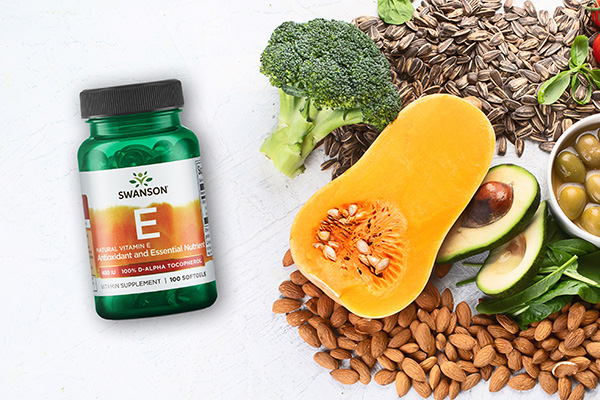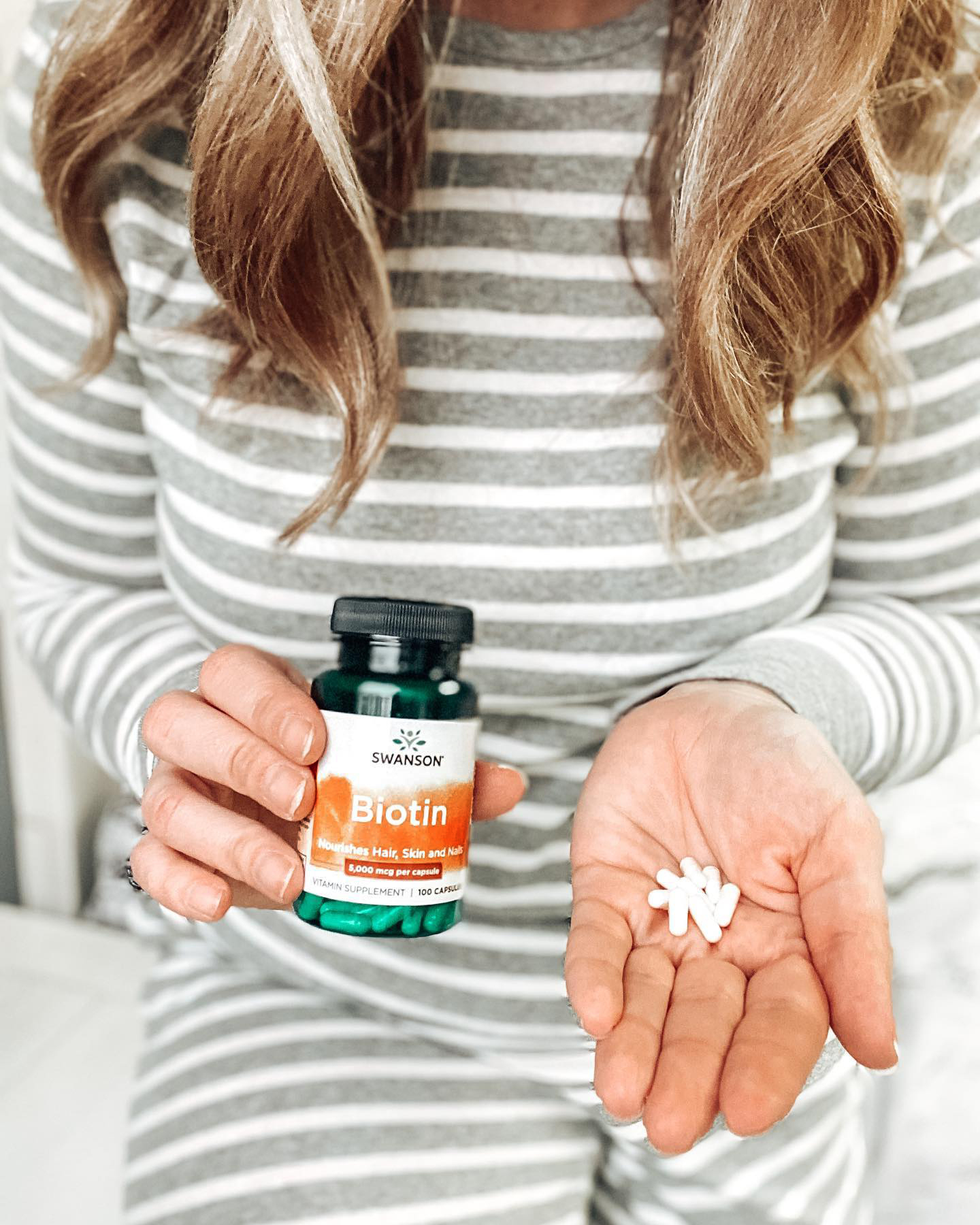The Health Benefits of Vitamin E
Vitamin E has been a part of Swanson since the very beginning. In fact, it was the supplement that started it all. In the late 1950s, our founder Leland Swanson was an avid golfer who had begun to experience discomfort in his joints. Seeking a natural solution, he began researching current literature and discovered the many benefits of vitamin E.
With this knowledge in hand, Swanson Health was launched in 1969 offering vitamin E supplements through mail-order catalog. The rest, as they say, is history, but our understanding of this incredible vitamin and its benefits to health and overall wellbeing have only continued to grow.
Vitamin E is an essential letter vitamin well-known for its many health benefits. First discovered in 1922,1 this vitamin has been shown to play an important role in a number of bodily systems, including vision and reproduction, in addition to supporting brain, skin and bone health.2
But the health benefits of vitamin E don’t stop there! Vitamin E has been linked to supporting immune health and also playing a part in cellular signaling and gene regulation.3 Additionally, vitamin E delivers potent defense against oxidative stress, which can occur due to the creation of free radicals within the body as a result of exposure to pollution or as a part of the process of energy metabolism.3
What is Vitamin E
The benefits of this vitamin are impressive, but what is vitamin E? Vitamin E is a fat-soluble vitamin,4 meaning that it is best absorbed in the presence of fat (with food) and can be stored in the body for later use as needed. It can not be made endogenously, so it must be gained from food or supplementation.
The term “vitamin E” refers to eight fat-soluble compounds.5 Of these, alpha-tocopherol is the chemical form best utilized by the human body to gain the benefits of vitamin E.3 This form is best absorbed by the liver for metabolism and use by the body. The remaining forms of vitamin E are also metabolized by the liver but are only found in very small amounts in the blood and cells after excretion, and so are not considered to be overly beneficial.3
Types of Vitamin E
Vitamin E is most generally available in either a natural or a synthetic form. Natural vitamin E may be broken down into one of two classes: tocopherols or tocotrienols. Both forms can be further reduced into alpha, beta, gamma and delta sub forms. Both classes of natural vitamin E deliver health benefits, including antioxidant support. This is achieved by their ability to lend extra electrons to free radicals in order to defend against oxidative stress.6
Typically, natural vitamin E will be listed on labels as d-alpha-tocopherol. The natural form of vitamin E is characterized by having a single isomer and has generally been found in clinical studies to be better absorbed and metabolized by the body.7
Synthetic vitamin E is characterized by containing eight isomers, of which only one is identical to the natural form of d-alpha tocopherol.6 Synthetic vitamin E is commonly listed as dl-alpha-tocopherol and is generally derived from petroleum products.8 While synthetic vitamin E delivers similar antioxidant support to natural vitamin E, studies have shown that it’s less bioavailable and may be excreted from the body more swiftly.9
The most potent, bioavailable type of vitamin E appears to be the natural form known as alpha-tocopherol. For best results, it is suggested that vitamin E supplements should include multiple forms of natural tocopherols.10
What are the Benefits of Vitamin E?
Let’s look at some of the many benefits of vitamin E in specific contexts.
Benefits for Men
Vitamin E is considered beneficial for men for specifically supporting testosterone production and bolstering overall reproductive health.11
Benefits for Women
Vitamin E delivers a range of benefits for women, including as a powerful antioxidant known to protect against the free radicals which can often challenge overall wellbeing, particularly as relates to women’s health concerns. As such, vitamin E has been studied for its ability to support reproductive health in women.12
Benefits for Skin
Studies have shown that vitamin E can promote overall skin health.13 Likewise, vitamin E has been linked to increased skin hydration, which has been shown to promote tissue health.14
Benefits for Hair
Vitamin E’s antioxidant support may promote healthy hair by defending against the oxidative stress that can impact the health of hair follicles. As such, vitamin E has been considered helpful in maintaining overall scalp health.15
How to Consume Vitamin E?
When it comes to deciding how to take vitamin E, there are many options available. While it’s always best to get nutrients from healthy foods, some gaps may exist in your diet which supplements can help fill. Vitamin E is generally available in the following forms:
- Lotions and creams (for topical application)
- Softgels
- Liquid
- Oil
- Tablets (including vegetarian)
- Capsules (including vegetarian)
- Powder
- Gummies
How Much Vitamin E Should You Take?
Vitamin E dosage is something which should always be discussed with a health care provider before beginning any new regimen. However, some general guidelines are listed here:16
- Children aged one to three years: 6 mg daily
- Children aged 9-13 years: 11 mg daily
- Those aged over 14 years: 15 mg daily
- Pregnant or lactating women are encouraged to consume up to 19 mg daily
Where Does Vitamin E Come From?
Looking for ways to add vitamin E to your diet? Vitamin E can be found in many food sources, such as sunflower seeds, peanut butter, broccoli, kiwi fruit or tomatoes.
Here is a list of these and other food sources and their relative level of natural vitamin E:3
- 1 oz sunflower seeds: 7.4 mg
- 1 oz almonds: 6.8 mg
- 2 tbsp peanut butter: 2.9 mg
- 1 tbsp corn oil: 1.9 mg
- 1/5 cup broccoli: 1.2 mg
- 1 medium kiwi fruit: 1.1 mg
- 1 medium tomato: 0.7 mg
To learn more about vitamin E and other letter vitamins, be sure to check out Amazing Alphabet Vitamins: The Six Vitamins You Need to Know
Always serving our customers,
Your friends at Swanson
*These statements have not been evaluated by the Food and Drug Administration. These products are not intended to diagnose, treat, cure, or prevent any disease.
Sources
1. History of Vitamin E. PubMed. Read source
2. Vitamin E. Mayo Clinic. Read source
3. Vitamin E. National Institutes of Health. Read source
4. Vitamin E. Harvard School of Public Health. Read source
5. 8 Unique Benefits of Vitamin E. HealthLine. Read source
6. There’s More Than One Type of Vitamin E. Today’s Geriatric Medicine. Read source
7. Natural vs. Synthetic Vitamin E. Nutrition Science News. Read source
8. Vitamin E: Synthetic or Natural? Poulin Grains. Read source
9. A Comparison of Natural and Synthetic Vitamin E. Asian-Australasian Journal of Animal Sciences. Read source
10. The Truth About Vitamin E. BMJ. Read source
11. Low Libido is Helped by Vitamin E Family. Pacific Center for Naturopathic Medicine. Read source
12. Vitamin E as an Antioxidant in Female Reproductive Health. Read source
13. Prevention of DNA Photodamage by Vitamin E. PubMed. Read source
14. The Importance of Hydration in Wound Healing. PubMed. Read source
15. Is Vitamin E Good for your Hair? Medical News Today. Read source
16. How Much Vitamin E Should I Take? HealthLine. Read source



